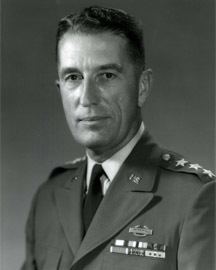Nickname(s) "Gentleman Jim" Name James Woolnough | Years of service 1932-1970 | |
 | ||
Born October 24, 1910Mindanao, Philippine Islands ( 1910-10-24 ) Commands held Continental Army Command1st Cavalry Division Battles/wars World War IIKorean WarCold War Awards Distinguished Service Medal (2)Silver StarBronze Star Medal (2)Purple HeartCombat Infantryman Badge People also search for Arthur W. Radford, Edward A. Craig, Joseph Stalin | ||
Allegiance United States of America | ||
James Karrick Woolnough (October 24, 1910 – May 30, 1996) was a United States Army four-star general who served as Commanding General of the United States Continental Army Command at Fort Monroe, Virginia. In this capacity he was responsible for the command and control of all active and reserve forces in the Six Armies of the Continental United States from 1967 to 1970.

Military career
Born in Mindanao, Philippine Islands of Colonel and Mrs. James B. Woolnough, Woolnough attended the United States Military Academy at West Point, graduating in 1932. Further training included the U.S. Army Infantry School at Fort Benning and the National War College at Fort McNair, Washington, D.C. Additionally he was both a math instructor and a Regimental Commander at West Point.
During his 38 years of active duty, Woolnough held a variety of staff and command positions worldwide. Shortly after the D-Day Normandy Beach landing, June 1944, he became executive officer of the 16th Infantry, 1st Infantry Division. In February 1945, during the Battle of the Bulge, he assumed command of the 393rd Infantry Regiment, 99th Infantry Division, which later provided the vanguard forces to prevent the German destruction of the Remagen Bridge, thus making it possible for the U.S. forces to cross the Rhine.
In September 1950 he was sent to Korea, given a map, and instructed to head north to find the 1st Cavalry Division, which he did and for a time commanded the 7th Cavalry Regiment, the Garry Owen. Eleven years later, as a Major General, he returned to Korea as the 1st Cavalry Division Commanding Officer.
In the Pacific theater on Joint Task Force Seven he was Deputy Plans and Operations Officer for the first atomic tests at Eniwetok. Years later as a Lieutenant General in 1963, he was Deputy Commander-in-Chief, U.S. Army Pacific at Fort Shafter, Hawaii.
Among his many assignments during his eighteen years in the Pentagon he served as Chief of Staff of the NATO Standing Group, Director of Operations as well as Director of Plans for the U.S. Army General Staff, and Deputy Chief of Staff for Personnel, Department of the Army.
Upon retirement on October 31, 1970, Woolnough returned to his family home in Arlington, Virginia.
Woolnough died at Walter Reed Army Medical Center, and was buried in Arlington National Cemetery next to his wife, Mary Agnes Woolnough, who died in 1980. He was survived by his second wife, Mary Dabinet Woolnough.
